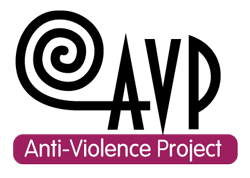What is it like to volunteer with AVP?
As you may have heard, AVP’s annual volunteer training is beginning in May this year instead of September! If you are thinking of applying to volunteer with AVP, you may have already checked out the Volunteering with AVP page on our website. As you can see on there, volunteer training consists of about 30-40 hours of workshops on a variety of related topics including colonization, sexualized violence, consent, sex positivity, gender beyond the binary, and self and community care. All of this is approached from an anti-colonial, intersectional, sex-positive framework.
But what is it actually like to participate in this training process?
I started volunteering with AVP in 2016, and this past year got to attend volunteer training again, this time as AVP’s work study. Below are some thoughts I’ve compiled from a few current and past volunteers, along with my own experiences, to try to give potential volunteers an idea of what volunteer training is like…
It’s informative
AVP’s volunteer training is in-depth and expansive. The material engaged with throughout training covers a lot of intersecting topics. As one volunteer put it, it’s not just about preparing individuals for what tasks they will be doing as volunteers—it’s about what knowledge and experience individuals can gain to take with them beyond AVP. That being said, the same volunteer did mention that training prepared her very well for the volunteer tasks she has taken on, including doing peer support hours and facilitating workshops.
Outside of the basic training hours, volunteers receive lots of support and extra practice when they need it. The staff are adaptive to volunteer needs—setting up additional workshops to practice specific skills or meeting one-on-one with volunteers to chat about the material covered.
To give you an idea of some of the specific information volunteer training covers, here is a small sample of the highlights named by volunteers:
- unlearning myths about gender-based violence
- gaining a deeper understanding of the historical and ongoing colonization of the lands we work and live on and, crucially, how colonization is so connected to gender based violence
- looking at examples of the ways that people resist violence and oppression
- developing skills for supporting survivors of gender-based violence, as a volunteer and in our own lives
- talking about sex positivity and desire (named by many as one of the funnest days of volunteer training)
- learning about neurodiversity (also a favourite of many volunteers)
It’s challenging (in a good way)
Volunteer training can be really uncomfortable, but that’s awesome because we learn through discomfort! Many volunteers have described training as “uncomfortable but safe,” as we are learning about sexualized violence and oppression, an uncomfortable subject, in a safe environment. For myself, one of the most meaningful experiences I had in volunteer training was being “called in” after saying something unintentionally harmful. It was really tough to learn how to be accountable for my mistake instead of becoming defensive, but once I did I was able to learn so much from the people calling me in.
Another volunteer told me one of the most challenging and best parts of volunteer training was realizing how much she didn’t know about things she thought she did, taking accountability, and unlearning some of the myths that she had been reproducing without realizing. Volunteer training asks us to reflect on our own lives, identities, actions, thoughts and beliefs.
It meets you where you are at
Everyone comes into volunteer training with different knowledge and experiences—including the AVP staff and the folks facilitating each day! For some people the topics covered are familiar, but not for everyone so there is no assumption of pre-existing knowledge on any topic. AVP strives to “meet people where they’re at” and make the material and workshop space accessible to as many people as possible.
It’s a commitment (but it’s worth it)
Volunteer training is about 40 hours total, and many volunteers commit 1-3 hours per week to volunteer tasks after training. This can definitely be a big time commitment, especially when it’s on top of school, work, or other responsibilities. This is part of the reason why AVP has split volunteer training into May and September sessions this year. Volunteers who contributed to this blog post emphasized that although it’s a commitment, volunteering with AVP is “worth it.” Training days are so packed with learning and activity that they often fly by.
It’s a chance to build community
While the time commitment of volunteer training can be a lot, one volunteer actually named it as one of the best parts! By meeting regularly volunteers have the opportunity to get to know each other and build community. The relationships formed by going through this learning experience together can be wonderful and lasting. One volunteer mentioned how she was recently able to attend an event outside of AVP because she had met someone in training who helped make the event more accessible for her. Personally, when I first volunteered with AVP I was new to Victoria and hardly knew anyone, and the friends I made in training really helped me feel more at home. We still hang out outside of AVP two years later!
It’s an opportunity to make an impact in your daily life
Each of the volunteers I talked to said that volunteer training really improved their understandings of themselves and the world around them. One volunteer highlighted the discussion about family history and ancestry as foundational for them moving forward in the training, while another emphasized that it’s a great opportunity to “learn about yourself.”
If you’re interested in attending volunteer training, that volunteer also said that it’s “a really good time.” If you haven’t yet, AVP encourages you to check out our volunteer training page. If you have any questions about the training, we’re available by email, phone and in-person. We really hope we can learn together with you this year!







